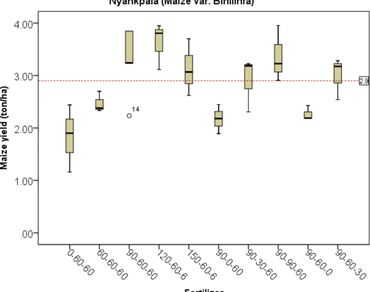Growth and yield of maize towards N–P2O5–K2O recommendation in Northern Ghana
Moahmmed Askia Musah, Mahama George Yakubu, Issah Alidu Abukari, Haruna Bashiru, Seidu Yussif, Ayuba Jalilatu, Haruna Abdulai, Jnr Ibrahim Yussif, Krofa Emmanuel Ofosu, Abubakari Mutari
Research Articles | Published: 07 September, 2023
First Page: 1662
Last Page: 1668
Views: 3501
Keywords: Maize, Fertilizer response, n Ferric Luvisoln , Marginal rate of returns, Yield parameters
Abstract
A 3-year (2015–2017) field experiment was conducted in Ghana, Nyankpala (09o 23’ 33.8” N, 001o 00’ 24.2” W, 169 m asl) to determine fertilizer recommendation for maize (Zea mays L.) on Ferric Luvisols. Ten N–P2O5–K2O rates were formulated from five levels of N (0, 60, 90, 120, and 150 kg/ha), four levels of P2O5 (0, 30, 60 and 90 kg/ha) and three levels of K2O (0, 30 and 60 kg/ha) and tested in 2015 and 2016 cropping seasons. Plots of 5 m × 4.5 m were planted to maize at 75 cm × 40 cm to maturity stages. The maize to nutrient response functions developed after the 2015 trials were: Y = 1.753 + 0.0207 N-0.0001N2, at 60 kg/ha P2O5 and 60 kg/ha K2O (R2 = 0.55); Y = 2.153 + 0.0339(P2O5)-0.0002(P2O5)2, at 90 kg/ha N and 60 kg/ha K2O (R2 = 0.66); and Y = 2.267 + 0.0292(K2O)-0.0002(K2O )2, at 90 kg/ha N and 60 kg/ha P (R2 = 0.78). The 2016 results revealed superior yields and yield parameters for 90-60-60, 90-90-60, 120-60-60, and 150-60-60 kg/ha. The four superior rates and a control (0-0-0) were further evaluated in the 2017 cropping season. The grain yields ranged from 710 kg/ha in the control to 3259 kg/ha under 150-60-60 kg/ha. The economic analysis indicated 90-60-60 kg/ha as the best N–P2O5–K2O rate for higher returns in investment (68.2%). However, further studies could be conducted on farmers’ fields to validate the recommendation.

References
Abbasi MK, Tahir MM, Rahim N (2013) Effect of N fertilizer source and timing on yield and N use efficiency of rainfed maize (Zea mays L.) in Kashmir-Pakistan. Geoderma 195–196. https://doi.org/10.1016/j.geoderma.2012.11.013
Abunyewa AA, Mercer-Quarshie H (2004) Response of maize to magnesium and zinc application in the semi-arid zone of West Africa. Asian J Plant Sci 3(1):1–5
Adepetu JA, Corey RB (1976) Organic phosphorus as a predictor of plant-available phosphorus in soils of southern nigeria. Soil Sci 122(3). https://doi.org/10.1097/00010694-197609000-00006
Adu SV, Asiamah RD (2003) Soils of the Yapei-Sawla Road area, Northern Region, Ghana
Ahiabor BDK, Fosu M, Tibo I (2010) Effect of pre-crop type on growth and yield of maize on two soils in the Guinea Savannah zone of Ghana. West Afr J Appl Ecol 17:55–63
Ahmed M, Rauf M, Mukhtar Z, Saeed NA (2017) Excessive use of nitrogenous fertilizers: an unawareness causing serious threats to environment and human health. In Environmental Science and Pollution Research (Vol. 24, Issue 35). https://doi.org/10.1007/s11356-017-0589-7
Banful AB (2009) “Operational Details of 2008 Fertilizer subsidy in Ghana - Preliminary report,” Ghana Dtrategy Support Program (GSSP) Background Paper 18, IFPRI - Accra
Banful AB (2010) Market-Smart ? Lessons from the 2008 and 2009 Fertilizer Subsidy Programs in Ghana. In Ghana Strategy Support Program (GSSP)
Braimoh AK, Vlek PLG (2006) Soil quality and other factors influencing maize yield in northern Ghana. Soil Use Manag 22(2). https://doi.org/10.1111/j.1475-2743.2006.00032.x
Charles CM, Gobena H (2011) Timely information on agriculture and natural resources. Agron Soil Ser, 2–11
Chen K, Kumudini SV, Tollenaar M, Vyn TJ (2015) Plant biomass and nitrogen partitioning changes between silking and maturity in newer versus older maize hybrids. Field Crops Research 183. https://doi.org/10.1016/j.fcr.2015.08.013
Ezui G, Haugen-Kozyra K, Heaney D, Nirjan L, Graham C, Njoroge S, Zingore S, Bruulsema T (2022) Can 4R practices limit the nitrous oxide emissions from increasing fertilizer use in sub-Sahara Africa?
FAO (2005) Fertilizer use by crop in Ghana. Land and Plant Nutrition Management Division Service, Land and Water Development Division, Food and Agriculture Organization of the United Nations, Rome
FAO (2014) FAOSTAT 2014: FAO Statistical Databases. In Food and Agriculture Organization of the United Nations: FAOSTAT
FAOSTAT (2020) Crops and livestock products data 2020. In Faostat
Fosu M, Kühne RF, Vlek PLG (2004) Improving maize yield in the Guinea Savannah Zone of Ghana with Leguminous cover crops and PK fertilization. J Agron, 3(2)
Hill AE (2014) Maize response to fertilizer and fertilizer-use decisions for farmers in Ghana (pp. 1–95)
Jaliya MM, Falaki AM, Mahmud M, Sani YA (2008) Effect of sowing date and NPK fertilizer rate on yield and yield components of quality protein maize (Zea mays L.). ARPN J Agricultural Biol Sci, 3(2)
Kaizzi KC, Byalebeka J, Semalulu O, Alou I, Zimwanguyizza W, Nansamba A, Musinguzi P, Ebanyat P, Hyuha T, Wortmann CS (2012) Maize response to fertilizer and nitrogen use efficiency in Uganda. Agron J 104(1). https://doi.org/10.2134/agronj2011.0181
Kamprath EJ, Moll RH, Rodriguez N (1982) Effects of Nitrogen fertilization and recurrent selection on performance of hybrid populations of corn 1. Agron J 74(6). https://doi.org/10.2134/agronj1982.00021962007400060007x
Kanton RAL, Buah SSJ, Larbi A, Mohammed AM, Bidzakin JK, Yakubu EA (2017) Soil Amendments and Rotation Effects on Soybean and Maize Growths and Soil Chemical Changes in Northern Ghana. International Journal of Agronomy, 2017. https://doi.org/10.1155/2017/4270284
Meng Q, Yue S, Hou P, Cui Z, Chen X (2016) Improving Yield and Nitrogen Use Efficiency Simultaneously for Maize and Wheat in China: A Review. In Pedosphere (Vol. 26, Issue 2). https://doi.org/10.1016/S1002-0160(15)60030-3
Onasanya RO, Aiyelari OP, Onasanya A, Nwilene FE, Oyelakin OO (2009) Effect of different levels of nitrogen and phosphorus fertilizers on the growth and yield of maize (Zea mays L.) in Southwest Nigeria. Int J Agricultural Res 4(6). https://doi.org/10.3923/ijar.2009.193.203
SARI (2001) CSIR-SARI Annual Report (pp. 1–10)
Subedi KD, Ma BL (2005) Ear position, leaf area, and contribution of individual leaves to grain yield in conventional and leafy maize hybrids. Crop Sci 45(6). https://doi.org/10.2135/cropsci2004.0653
Tetteh FM, Nurudeen AR (2015) Modeling site-specific fertilizer recommendations for maize production in the Sudan savannah agro-ecology of Ghana. Afr J Agric Res, 10(11)
Author Information
Tamale Technical University, Tamale, Ghana